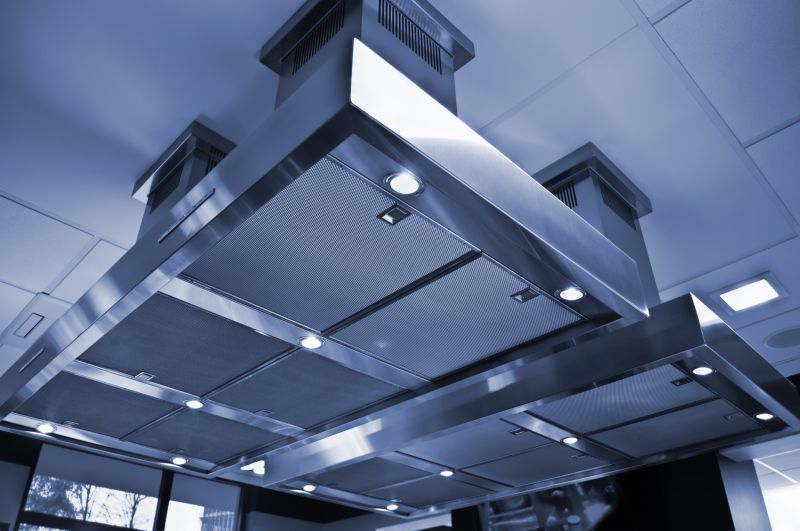Leading Choices for Restaurant Hood Ventilation to Support Safe Cooking Environments
Explore top ventilation products designed to enhance safety, reduce fire risks, and ensure regulatory compliance.
 Effective ventilation is a critical component in any restaurant environment, ensuring the removal of smoke, grease, odors, and heat generated during food preparation. Properly designed hood ventilation systems help maintain a comfortable and safe workspace for staff while also complying with health and safety regulations. These systems typically consist of hoods, ductwork, filters, and exhaust fans, working together to facilitate efficient airflow and pollutant removal. Selecting the right products for restaurant hood ventilation involves understanding various configurations, materials, and features that suit different kitchen layouts and cooking styles.
Effective ventilation is a critical component in any restaurant environment, ensuring the removal of smoke, grease, odors, and heat generated during food preparation. Properly designed hood ventilation systems help maintain a comfortable and safe workspace for staff while also complying with health and safety regulations. These systems typically consist of hoods, ductwork, filters, and exhaust fans, working together to facilitate efficient airflow and pollutant removal. Selecting the right products for restaurant hood ventilation involves understanding various configurations, materials, and features that suit different kitchen layouts and cooking styles.
Top Overall Option
Commercial Range Hood Ventilation System
A comprehensive commercial range hood ventilation system is designed to handle high-volume cooking environments, offering robust extraction capabilities and durable construction. These systems typically feature adjustable baffle filters, efficient exhaust fans, and customizable ductwork options to suit various kitchen layouts. They are engineered to effectively capture grease, smoke, and odors, promoting a cleaner and safer workspace. When selecting a system, considerations such as size, airflow capacity, and ease of maintenance are key to ensuring optimal performance and longevity.
Types of Products For Restaurant Hood Ventilations
Wall-Mounted Range Hoods
Designed to be mounted directly on kitchen walls, these hoods are suitable for kitchens with limited space and provide efficient capture of cooking fumes.
Island Range Hoods
Installed over central cooking islands, these hoods offer 360-degree coverage and are ideal for open-concept kitchen layouts.
Undermount Hoods
Integrated beneath cabinets or counters, these hoods provide discreet ventilation solutions for specialized cooking stations.
Canopy Hoods
Large, open-front hoods that extend over multiple burners, suitable for high-capacity commercial kitchens requiring extensive airflow.
Ductless (Recirculating) Hoods
Use filters to clean air before recirculating it back into the kitchen, ideal for spaces where ductwork installation is challenging.
Grease Filters
Specialized filters designed to trap grease particles, essential for maintaining cleanliness and safety in ventilation systems.
Exhaust Fans
Powerful fans that expel contaminated air from the kitchen, critical for maintaining air quality and compliance.
Air Make-Up Units
Supplement fresh air into the kitchen environment to replace exhausted air, ensuring proper ventilation balance.
Fire Suppression Hoods
Integrated systems that combine ventilation with fire suppression features for enhanced safety.
Custom Ductwork Components
Tailored duct solutions designed to optimize airflow and fit specific kitchen layouts.
Filter Cleaning Systems
Automated or semi-automated systems that facilitate easier grease filter maintenance.
Noise-Reducing Ventilation Units
Designed to minimize operational noise, improving kitchen environment comfort.
Popular Choices
A common choice for many kitchens, offering effective ventilation with space-saving design.
Favored for open kitchens, providing comprehensive coverage over central cooking stations.
Popular in retrofit projects or spaces where duct installation is limited, using filters to clean air.
Essential for capturing grease particles and maintaining clean ventilation systems.
Widely used for their ability to expel contaminated air efficiently.
Common in high-capacity kitchens, designed to handle large volumes of cooking fumes.
Chosen for their sleek appearance and space-efficient design.
Important safety feature in many commercial kitchens, combining ventilation with fire safety.
Often paired with exhaust systems to maintain proper air exchange.
Selected for quieter operation in busy kitchen environments.
In addition to functional performance, durability and ease of maintenance are important considerations. High-quality materials resistant to corrosion and grease buildup can extend the lifespan of the system and reduce downtime. Features such as adjustable airflow, noise reduction, and easy filter access can enhance operational efficiency and staff comfort. When choosing ventilation products, it is essential to consider the size of the kitchen, the volume of cooking activity, and local codes to ensure optimal performance and compliance.
Furthermore, integrating modern ventilation solutions can improve energy efficiency and streamline cleaning processes. Many systems now incorporate innovative designs that facilitate easier filter replacement and duct cleaning. Properly selected and maintained ventilation products contribute significantly to a safe, compliant, and pleasant kitchen environment, supporting the overall success of a restaurant operation.
Key Buying Considerations
- Kitchen size and layout to determine appropriate hood size and type
- Volume of cooking activity to select adequate airflow capacity
- Type of cooking equipment and heat output
- Material durability and resistance to grease and corrosion
- Ease of filter access and cleaning procedures
- Noise levels during operation
- Compatibility with existing ductwork or need for ductless options
- Compliance with local safety and ventilation codes
- Energy efficiency features to reduce operational costs
- Availability of maintenance and replacement parts
- Design aesthetics that match kitchen decor
- Installation requirements and space constraints
- Safety features such as fire suppression integration
- Budget considerations and long-term maintenance costs
- Manufacturer reputation and product warranties
This content contains affiliate links and we may earn a commission at no additional cost to you.
